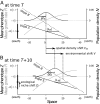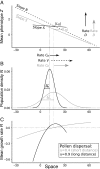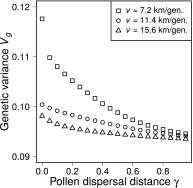Pollen dispersal slows geographical range shift and accelerates ecological niche shift under climate change
- PMID: 27621443
- PMCID: PMC5047147
- DOI: 10.1073/pnas.1607612113
Pollen dispersal slows geographical range shift and accelerates ecological niche shift under climate change
Abstract
Species may survive climate change by migrating to track favorable climates and/or adapting to different climates. Several quantitative genetics models predict that species escaping extinction will change their geographical distribution while keeping the same ecological niche. We introduce pollen dispersal in these models, which affects gene flow but not directly colonization. We show that plant populations may escape extinction because of both spatial range and ecological niche shifts. Exact analytical formulas predict that increasing pollen dispersal distance slows the expected spatial range shift and accelerates the ecological niche shift. There is an optimal distance of pollen dispersal, which maximizes the sustainable rate of climate change. These conclusions hold in simulations relaxing several strong assumptions of our analytical model. Our results imply that, for plants with long distance of pollen dispersal, models assuming niche conservatism may not accurately predict their future distribution under climate change.
Keywords: adaptation; cline; extinction threshold; gene flow; spatial heterogeneity.
Conflict of interest statement
The authors declare no conflict of interest.
Figures








References
-
- Parmesan C. Ecological and evolutionary responses to recent climate change. Annu Rev Ecol Evol Syst. 2006;37(1):637–669.
-
- Selwood KE, McGeoch MA, Mac-Nally R. The effects of climate change and land-use change on demographic rates and population viability. Biol Rev Camb Philos Soc. 2015;90(3):837–853. - PubMed
-
- Urban MC. Accelerating extinction risk from climate change. Nature. 2015;348(6234):571–573. - PubMed
-
- Davis MB, Shaw RG, Etterson JR. Evolutionary responses to changing climate. Ecology. 2005;86(7):1704–1714.
Publication types
MeSH terms
LinkOut - more resources
Full Text Sources
Other Literature Sources
Medical

